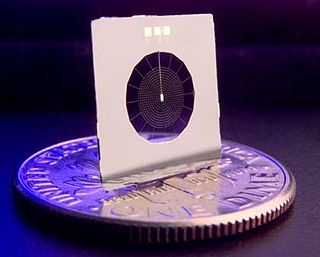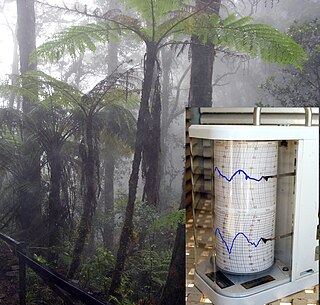
In physics, cryogenics is the production and behaviour of materials at very low temperatures.

A thermocouple is an electrical device consisting of two dissimilar electrical conductors forming electrical junctions at differing temperatures. A thermocouple produces a temperature-dependent voltage as a result of the thermoelectric effect, and this voltage can be interpreted to measure temperature. Thermocouples are a widely used type of temperature sensor.

A thermistor is a type of resistor whose resistance is dependent on temperature, more so than in standard resistors. The word is a portmanteau of thermal and resistor. Thermistors are widely used as inrush current limiters, temperature sensors, self-resetting overcurrent protectors, and self-regulating heating elements.

The electrical resistance of an object is a measure of its opposition to the flow of electric current. The inverse quantity is electrical conductance, and is the ease with which an electric current passes. Electrical resistance shares some conceptual parallels with the notion of mechanical friction. The SI unit of electrical resistance is the ohm (Ω), while electrical conductance is measured in siemens (S).

A bolometer is a device for measuring the power of incident electromagnetic radiation via the heating of a material with a temperature-dependent electrical resistance. It was invented in 1878 by the American astronomer Samuel Pierpont Langley.

A hygrometer is an instrument used to measure the amount of humidity and water vapour in the atmosphere, in soil, or in confined spaces. Humidity measurement instruments usually rely on measurements of some other quantity such as temperature, pressure, mass, a mechanical or electrical change in a substance as moisture is absorbed. By calibration and calculation, these measured quantities can lead to a measurement of humidity. Modern electronic devices use temperature of condensation, or changes in electrical capacitance or resistance to measure humidity differences. The first crude hygrometer was invented by the Italian Renaissance polymath Leonardo da Vinci in 1480 and a more modern version was created by Swiss polymath Johann Heinrich Lambert in 1755. Later in the year 1783, Swiss physicist and Geologist, Horace Bénédict de Saussure invented the first hygrometer using human hair to measure humidity.
Resistance thermometers, also called resistance temperature detectors (RTDs), are sensors used to measure temperature. Many RTD elements consist of a length of fine wire wrapped around a ceramic or glass core but other constructions are also used. The RTD wire is a pure material, typically platinum, nickel, or copper. The material has an accurate resistance/temperature relationship which is used to provide an indication of temperature. As RTD elements are fragile, they are often housed in protective probes.
The International Temperature Scale of 1990 (ITS-90) published by the Consultative Committee for Thermometry (CCT) of the International Committee for Weights and Measures (CIPM) is an equipment calibration standard for making measurements on the Kelvin and Celsius temperature scales. ITS-90 is an approximation of the thermodynamic temperature scale that facilitates the comparability and compatibility of temperature measurements internationally. It specifies fourteen calibration points ranging from 0.65±0 K to 1357.77±0 K and is subdivided into multiple temperature ranges which overlap in some instances. ITS-90 is the latest of a series of International Temperature Scales adopted by CIPM since 1927. Adopted at the 1989 General Conference on Weights and Measures, it supersedes the International Practical Temperature Scale of 1968 and the 1976 "Provisional 0.5 K to 30 K Temperature Scale". CCT has also adopted a mise en pratique in 2011. The lowest temperature covered by ITS-90 is 0.65 K. In 2000, the temperature scale was extended further, to 0.9 mK, by the adoption of a supplemental scale, known as the Provisional Low Temperature Scale of 2000 (PLTS-2000).

Temperature measurement, also known as thermometry, describes the process of measuring a current local temperature for immediate or later evaluation. Datasets consisting of repeated standardized measurements can be used to assess temperature trends.
Cryogenic particle detectors operate at very low temperature, typically only a few degrees above absolute zero. These sensors interact with an energetic elementary particle and deliver a signal that can be related to the type of particle and the nature of the interaction. While many types of particle detectors might be operated with improved performance at cryogenic temperatures, this term generally refers to types that take advantage of special effects or properties occurring only at low temperature.

The wet-bulb temperature (WBT) is the temperature read by a thermometer covered in water-soaked cloth over which air is passed. At 100% relative humidity, the wet-bulb temperature is equal to the air temperature and it is lower at lower humidity. It is defined as the temperature of a parcel of air cooled to saturation by the evaporation of water into it, with the latent heat supplied by the parcel. A wet-bulb thermometer indicates a temperature close to the true (thermodynamic) wet-bulb temperature. The wet-bulb temperature is the lowest temperature that can be reached under current ambient conditions by the evaporation of water only.
A medical thermometer is used for measuring human or animal body temperature. The tip of the thermometer is inserted into the mouth under the tongue, under the armpit, into the rectum via the anus, into the ear, or on the forehead.

Four-terminal sensing, 4-wire sensing, or 4-point probes method is an electrical impedance measuring technique that uses separate pairs of current-carrying and voltage-sensing electrodes to make more accurate measurements than the simpler and more usual two-terminal (2T) sensing. Four-terminal sensing is used in some ohmmeters and impedance analyzers, and in wiring for strain gauges and resistance thermometers. Four-point probes are also used to measure sheet resistance of thin films.
The alcohol thermometer or spirit thermometer is an alternative to the mercury-in-glass thermometer and has similar functions. Unlike the mercury-in-glass thermometer, the contents of an alcohol thermometer are less toxic and will evaporate quickly. The ethanol version is the most widely used due to the low cost and relatively low hazard posed by the liquid in case of breakage.
A Beckmann thermometer is a device used to measure small differences of temperature, but not absolute temperature values. It was invented by Ernst Otto Beckmann, a German chemist, for his measurements of colligative properties in 1905. Today its use has largely been superseded by electronic thermometers.

The Celsius scale, also known as the centigrade scale, is a temperature scale used by the International System of Units (SI). As an SI derived unit, it is used worldwide. In the United States, the Bahamas, Belize, the Cayman Islands and Liberia however, Fahrenheit remains the preferred scale for everyday temperature measurement. The degree Celsius can refer to a specific temperature on the Celsius scale or a unit to indicate a difference between two temperatures or an uncertainty. It is named after the Swedish astronomer Anders Celsius (1701–1744), who developed a similar temperature scale. Before being renamed to honor Anders Celsius in 1948, the unit was called centigrade, from the Latin centum, which means 100, and gradus, which means steps.

Temperature is a physical quantity expressing hot and cold. It is measured with a thermometer calibrated in one or more temperature scales. The most commonly used scales are the Celsius scale, Fahrenheit scale, and Kelvin scale. The kelvin is the unit of temperature in the International System of Units (SI). The Kelvin scale is widely used in science and technology.

A transition-edge sensor (TES) is a type of cryogenic energy sensor or cryogenic particle detector that exploits the strongly temperature-dependent resistance of the superconducting phase transition.
Scale of temperature is a way to measure temperature quantitatively. Empirical scales measure the quantity of heat in a system in relation to a fixed parameter, a thermometer. They are not absolute measures, that is why scales vary. Absolute temperature is thermodynamic temperature because it is directly related to thermodynamics. It is the Zeroth Law of Thermodynamics that leads to a formal definition of thermodynamic temperature.













